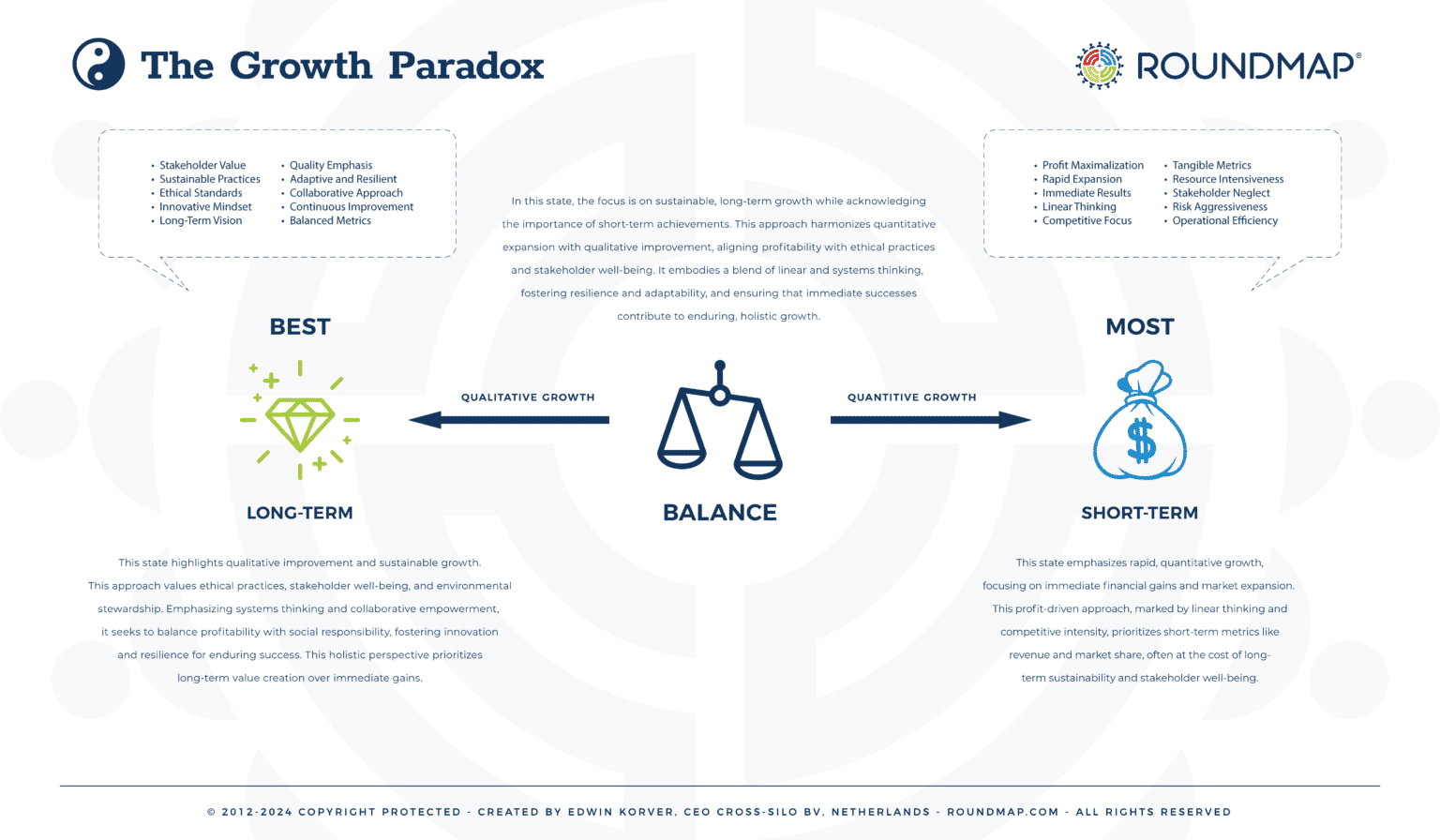In the relentless pursuit of growth, defined traditionally as more profit, revenue, customers, or market share, we find ourselves at a crucial crossroads. This relentless ‘more’ paradigm, deeply ingrained in our corporate and economic psyche, is increasingly at odds with the urgent imperatives of sustainability and societal well-being.
The United Nations’ Sustainable Development Goals, a universal call to action for ending poverty, protecting the planet, and ensuring peace and prosperity, starkly contrast this approach. Echoing this sentiment, Kate Raworth’s seminal work ‘Donut Economics’ further challenges us, illustrating how this unyielding quest for ‘more’ pushes our societies and the environment beyond the thresholds of what they can sustainably support.
In this context, we must ask ourselves: Is our conventional definition of growth truly serving us, or is it time to rethink and realign our growth strategies with these broader, more sustainable objectives?
The Traditional Growth Paradigm
Throughout history, the business world has predominantly operated under a quantitatively driven growth model. This relentless quest for quantitative growth has been the yardstick of measuring business success, the guiding star for strategies, and the driving force behind most corporate decisions.
However, this tight focus on quantitative metrics has significant implications and consequences for society and the environment. Firstly, it often leads to the depletion of natural resources, as the drive for more revenue and market share encourages the over-exploitation of materials and energy. This unsustainable use of resources significantly contributes to environmental issues like climate change, pollution, and biodiversity loss. The drive for constant expansion, while beneficial in the short term for economic growth, poses long-term risks to the planet’s ecological balance.
From a societal perspective, the pursuit of profit maximization can lead to various adverse outcomes. It prioritizes cost-cutting and efficiency over employee well-being, leading to job insecurity, poor working conditions, and widening income inequality. Corporations may overlook ethical considerations in the relentless quest for growth, affecting consumer rights, public health, and community welfare.
Moreover, this approach frequently fosters a culture of short-termism, where immediate gains are prioritized over sustainable, long-term planning. Such a mindset can stifle innovation, discourage investments in research and development, and ultimately hinder progress toward more sustainable business models.
While pursuing quantitative growth has historically driven economic development and corporate success, it is increasingly evident that this approach is unsustainable in the long term. The implications of prioritizing short-term financial metrics over environmental and social factors are profound, necessitating a critical reassessment of what actual growth should entail in a rapidly changing global landscape.
Contrasting Perspectives from Sustainable Development Goals and 'Donut Economics'
The United Nations Sustainable Development Goals (SDGs) represent a universal call to action, addressing global challenges, including poverty, inequality, climate change, environmental degradation, peace, and justice. Launched in 2015, these 17 Goals provide a shared blueprint for peace and prosperity for people and the planet, now and into the future. They signify a global recognition that economic growth cannot come at the expense of social and environmental well-being. The SDGs emphasize the need for holistic development that combines economic progress with environmental stewardship and social inclusion.
In parallel, ‘Donut Economics,’ a concept developed by economist Kate Raworth, offers a revolutionary perspective on how economies should operate in the 21st century. At the core of ‘Donut Economics’ is the visual framework of a donut, where the outer ring represents the ecological ceiling that we should not exceed to protect the Earth, and the inner ring depicts the social foundation below which nobody should fall. The space in between – the ‘dough’ of the donut – is the safe and just space for humanity. This model challenges traditional growth paradigms by arguing that the relentless pursuit of GDP growth overlooks critical social and ecological boundaries.
Raworth’s model urges a shift away from the traditional, linear economic thinking that focuses solely on GDP growth and towards a model that balances between these boundaries. It emphasizes the necessity of an economy that is regenerative by design, one that restores and replenishes the resources it uses rather than depleting them. Additionally, ‘Donut Economics’ advocates for economies to be distributive by nature, ensuring a fair and equitable distribution of wealth and resources, thus addressing inequality and promoting social cohesion.
Both the UN SDGs and ‘Donut Economics’ underscore the importance of balancing economic growth with social equity and environmental sustainability. They challenge the traditional growth model, which often prioritizes economic gains at the expense of environmental and social factors, advocating for a more holistic, integrated approach to development. This perspective aligns with the idea that long-term sustainability and prosperity depend on our ability to operate within these ecological limits and social thresholds, redefining what growth and progress mean in our interconnected world.
The Growth Paradox
The Growth Paradox lies at the heart of modern economic and business strategies, contrasting the traditional ‘more’ approach and the emerging recognition of the need for sustainable, long-term strategies. This paradox encapsulates the conflicting goals of pursuing relentless economic expansion versus adopting a more balanced, sustainable approach to growth.
On one hand, the traditional growth model has driven the global economy for decades, fueling innovation, industrialization, and technological advancements. However, prioritizing immediate financial returns and overlooking the broader impacts on society and the environment comes at a considerable price.
Ignoring this paradox can have dire consequences. Ecologically, it can lead to irreversible damage to our planet’s systems, pushing us beyond the safe environmental limits. Socially, a relentless focus on economic growth can exacerbate inequalities, undermine community well-being, and neglect the essential human values of fairness and justice. Economically, it risks creating unsustainable bubbles, leading to financial instability and crises.
On the other hand, sustainable, long-term strategies advocate for a responsible approach. These strategies recognize that growth isn’t just about increasing the bottom line but enhancing the quality of life, preserving the environment, and ensuring equity and fairness. This perspective aligns with the principles of ‘Donut Economics’ and the UN SDGs, which emphasize the need to operate within ecological boundaries while ensuring no one falls below the social foundation.
The need to address the Growth Paradox is not just a moral imperative but also an economic one. Businesses and economies adopting sustainable practices will likely be more resilient, adaptable, and innovative. They are better prepared to face the challenges of a rapidly changing world, from climate change to shifting societal expectations. In the long run, sustainable growth strategies can lead to more stable, robust economies and healthier societies.
The Growth Paradox presents a choice: continue with the unsustainable pursuit of more, or pivot towards a growth model that balances economic advancement with ecological integrity and social equity. This critical decision hinges on our planet’s future and future generations’ well-being.
Gary Hamel's The Future of Management
In his book, The Future of Management (2017), Gary Hamel argued that most management practices focus on those human capabilities that contribute least to (long-term) value creation.
According to Hamel, managers focus 80% of their time on developing human capabilities that lead to doing things better (quantitative growth):
- Obedience ─ “Do as told”
- Diligence ─ “Work harder”
- Intelligence ─ “Work smarter”
Consequently, only 20% of their time is being spent on developing capabilities that lead to doing better things (qualitative growth):
- Initiative ─ “Be proactive”
- Creativity ─ “Think different”
- Passion ─ “Follow your heart”
Given that developing new products and markets is risky, management must defend existing market share before transitioning into new viable lines of business. To deal with the scarcity of time and attention, Jeroen Kraaijenbrink on Linkedin suggested: Why not focus technology on the first three and have management and leadership develop the other three?
Hamel has been a proponent of organizational change that emphasizes more democratic and inclusive approaches to management, suggesting that traditional management practices often fail to fully engage the vast majority of an organization’s talent pool. This perspective advocates for systems that more effectively distribute leadership and decision-making, aiming to tap into the underutilized potential within the workforce.
Real-World Examples
To make our case, let’s consider some successful cases:
Panera Bread, led by its founder and CEO Ron Shaich. Shaich transformed Panera from a low-margin bakery into a thriving bakery café by focusing on what customers truly wanted – quality food, a sense of community, and a commitment to social causes. This customer-centric approach helped him build a business model centered around the mission of “food as it should be.” The Panera story exemplifies a shift from traditional profit-driven models to a mission-driven approach, balancing profitability with purpose and social responsibility. This shift created a profitable enterprise but also aligned the company’s operations, culture, and strategy with broader societal values. Continue reading here.
IKEA‘s IWAY initiative is a compelling example of how businesses can drive positive change through their supply chains. IWAY, IKEA’s supplier code of conduct, mandates that suppliers adhere to specific environmental and humanitarian standards. This includes core worker rights, workplace safety, work-life balance, water and waste management, and the prevention of child labor. Over 20 years, IKEA has refined IWAY, demonstrating a commitment to ensuring that their business practices align with strong Environmental, Social, and Governance (ESG) standards. This approach reinforces IKEA’s corporate responsibility and encourages a broader shift towards sustainable and ethical business practices in the global supply chain.
H&M‘s “Let’s Close the Gap” project exemplifies the principles of a circular economy (CE). Initiated in 2013, this project involves collecting and categorizing discarded clothing from customers. Items in good condition are restored and rehomed, while those at the end of their life are recycled for material reuse in new products. Customers are incentivized through tokens for discounts at H&M stores, creating a complete CE loop. By 2019, 57% of H&M’s raw materials were sustainable, with a target of 100% by 2030. This initiative shifts from traditional linear economic models to more sustainable, circular practices.
HSBC is making strides in green finance, committed to investing $100 billion in sustainability projects by 2025. As of 2019, they had funded over $50 billion in such projects. They developed an ESG risk evaluation framework in 2019 to ensure support for green initiatives. HSBC’s ESG practices earned them an AA rating from MSCI in 2021. Additionally, they aim to use 100% renewable energy by 2030 and reduce paper and single-use plastics consumption. For more insights into best ESG practices, you can explore their “Top 6 ESG Reporting Best Practices” article (link at the bottom).
Redefining Growth
- Stakeholder Value: This involves prioritizing the well-being and satisfaction of all stakeholders, which includes employees, customers, and the broader community. Understanding and addressing their needs leads to more inclusive and responsible business practices.
- Sustainable Practices: Focusing on environmental stewardship and implementing sustainable operational practices is essential for long-term viability and ecological balance.
- Ethical Standards: Committing to high ethical behavior and corporate social responsibility is crucial. This ensures that business operations align with moral principles and societal expectations.
- Innovative Mindset: Continual product, service, and process innovation is vital. This drives business growth and contributes to solving environmental and social challenges.
- Long-Term Vision: Adopting a strategic perspective focusing on long-term objectives rather than short-term gains ensures sustainable growth and success.
- Quality Emphasis: Prioritizing high-quality output over mere quantity helps build a robust and loyal customer base and a resilient brand reputation.
- Adaptive and Resilient: Flexibility and adaptability to changing market conditions and global trends ensure business continuity and relevance.
- Collaborative Approach: Encouraging teamwork and partnerships within the organization and with external entities fosters innovation and shared success.
- Continuous Improvement: Committing to ongoing learning and development is essential for adapting to new challenges and opportunities.
- Balanced Metrics: A comprehensive set of metrics that evaluate financial performance alongside social, environmental, and governance factors provides a more accurate picture of a company’s overall impact and success.
In summary, this new growth paradigm requires a shift from a singular focus on profits to a more integrated approach that values ethical, social, and environmental considerations alongside economic success.
Call to Action
Businesses, leaders, and policymakers are urged to rethink their approach to growth, moving towards a model that is both sustainable and holistic. Practical steps to achieve this include:
- Adopting Sustainable Business Practices: Implement environmentally friendly operations and socially responsible business strategies.
- Engaging with Stakeholders: Actively involve all stakeholders in decision-making to consider diverse perspectives and needs.
- Incorporating Ethical Standards: Uphold high ethical standards in all business operations and decisions.
- Fostering Innovation: Encourage and invest in innovative solutions that address environmental and social challenges.
- Implementing Long-Term Planning: Focus on strategic planning considering long-term impacts and sustainability.
- Using Balanced Performance Metrics: Employ a broad set of metrics that measure financial, social, and environmental performance.
By adopting these strategies, we can collectively work towards a future where growth is economically beneficial, socially responsible, and environmentally sustainable.
Conclusion
Redefining growth requires shifting from a traditional, quantity-focused paradigm to a sustainable, balanced approach. The critical arguments presented emphasize the need for ethical standards, stakeholder engagement, and long-term visions in business practices. By integrating these elements with innovation and systemic thinking, businesses and economies can achieve prosperity that balances economic success with environmental stewardship and social responsibility. This transformation is beneficial and essential for future generations, ensuring a world where growth and sustainability coexist harmoniously.
RoundMap’s ethos aligns seamlessly with the conclusion of redefining growth. As an entity that champions sustainable business success through whole-system thinking and stakeholder-driven leadership, RoundMap® embodies the shift from traditional growth models to sustainable, holistic strategies. Its focus on breaking silos, fostering collaboration, and encouraging continuous innovation exemplifies the commitment to balancing economic success with environmental and social responsibility. RoundMap® stands as a beacon for businesses transitioning to a future where prosperity is measured not just in financial terms but in the wellbeing of all stakeholders and the planet.
References and Further Reading
- United Nations ─ Sustainable Development Goals (SDGs)
- Panera Bread ─ Baking Meaningful Impact: Why Your Business Model Needs a Meaningful Mission
- HSBC ─ Top 6 ESG Reporting Best Practices
Author
-
Edwin Korver is a polymath celebrated for his mastery of systems thinking and integral philosophy, particularly in intricate business transformations. His company, CROSS/SILO, embodies his unwavering belief in the interdependence of stakeholders and the pivotal role of value creation in fostering growth, complemented by the power of storytelling to convey that value. Edwin pioneered the RoundMap®, an all-encompassing business framework. He envisions a future where business harmonizes profit with compassion, common sense, and EQuitability, a vision he explores further in his forthcoming book, "Leading from the Whole."
View all posts Creator of RoundMap® | CEO, CROSS-SILO.COM






